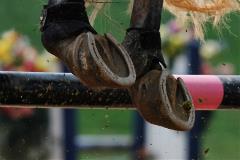Equine Needs: Corrective Trimming and Therapeutic Shoeing

Shoeing
Three of the most common reasons for shoeing a horse include:
- Preventing excessive hoof wear for animals worked, ridden, or living on rocky, rugged, and difficult terrain
- Providing performance animals with increased stability and traction
- Preventing sole injuries of animals that lack foot toughness.
Many problems in hoof care can be prevented by educating clients on ways to establish a hoof care regimen that includes:
- Daily inspection
- Daily hoof cleaning
- Routine hoof trimming
- Shoeing for animals that require them
Working Together
However, a different and more intensive approach to hoof care is necessary when the animal’s needs involve trimming and shoeing for therapeutic purposes. When horses require specialized hoof care, they need the input and expertise of both the veterinarian and the farrier. Working together, the veterinarian’s diagnosis will assist in the farrier’s development of a trimming and shoeing plan that will affect and influence the structures of the involved feet.
Information
Diagnosis for therapeutic hoof care requires gathering information from a variety of sources starting with the history of the animal. Depending on what is uncovered, knowing its background will help to form a clearer understanding of the animal’s need for specialized hoof care.
Information that pertains to the hooves includes such items as:
- Age
- Health
- Nutrition
- A well-balanced diet provides nutrients for sound hoof growth
- Inadequate nutrition can compromise the quality of an animal’s hooves
- Hoof growth can be negatively impacted by undernourishment
- Hoof growth can be greater in animals that are overfed
- Exercise
- Hooves tend to be healthier in appropriately exercised animals vs. those kept in stalls
- Environment and climate conditions
- In the colder months, hooves grow slower
- Natural wear of hooves is different for animals kept in soft vs. hard terrain.
Conformation
In order to evaluate the type of therapeutic care required, an examination that focuses on the conformation of the animal’s feet and limbs needs to be evaluated. Taken when the horse is standing at rest, this information will evaluate physical qualities, such as:
- Distribution of body weight upon the hooves
- Natural wear of the hooves
- Conformation issues that cause irregularities in the animal’s stride or landing
- Abnormalities that affect the mechanical forces upon the hooves and hoof bones, for example:
- Increases in pressure on the toe and/or heel
- Increases in pressure on the navicular bone
Radiography
Evaluating the need for corrective care should also involve obtaining a series of diagnostic radiographs. The x-ray images of bone and soft tissue will help to determine the animal’s hoof needs. The images and their assessment should be shared with the farrier in order to further develop a therapeutic hoof care plan.
Radiographic images provide useful hoof information such as:
- Measure of the sole depth
- Measure of the solar angles
- Determination of the balance of the individual feet
- Gauging the health of the coffin bone
- Ascertaining the relationship between the coffin bone and the hoof wall
Magnetic Resonance Imaging (MRI)
MRI machines also prove to be a significant diagnostic aid for determining an orthopedic hoof care plan. Capable of producing an image of bone, soft tissue, and cartilage, the MRI furthers the veterinarian’s understanding of the needs of the animal by providing a non-invasive representation of the actual structure of the animal’s limb and foot.
The information gathered on the animal will help in determining the veterinarian’s diagnosis for hoof needs. Working together, veterinarians and farriers can properly design and apply a therapeutic hoof care plan that will help to relieve the pain felt by animals requiring an orthopedic approach to hoof care.
Contact your Covetrus representative at 855.724.3461 to come up with a plan to best help your clients.
Information gathered from:
https://www.equinews.com/article/poor-nutrition-impacts-hooves
http://www.thehorse.com/articles/10144/shoeing-the-laminitic-horse
http://www.thehorse.com/articles/11286/equine-mri-opens-new-frontier-in-lameness-diagnosis-and-treatment


Working Here
Our team members are encouraged to be the best they can be... at Covetrus we believe we impact one another.
Learn MoreNews & Events
FDA Cautions Pet Owners Not to Feed Texas Tripe Inc. Raw Pet Food Due to Salmonella, Listeria Monocytogenes
The U.S. Food and Drug Administration is cautioning pet owners not to feed their pets any of the Texas Tripe brand raw frozen pet food listed below because several samples of Texas Tripe raw pet food have tested positive for Salmonella and/or L. mono.
Careers
Are you looking for a place to let your talents shine? At Covetrus, we help our practitioner customers better serve their patients and take pride in providing the best customer experience possible. Search our open positions to see our available opportunities.
Newsletter
Stay current with what’s going on with Covetrus, subscribe to receive our newsletter and email communications. Subscribers will receive the latest information in practice management, sales and marketing, animal health, and more.



-3-(1).png?sfvrsn=2d806d73_0)

Leave a comment